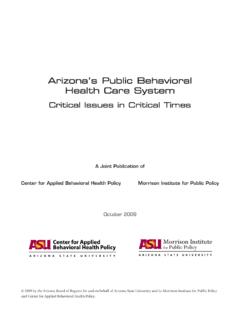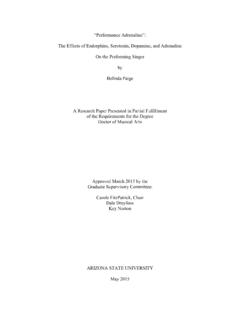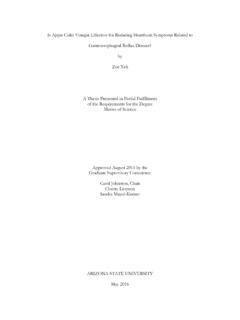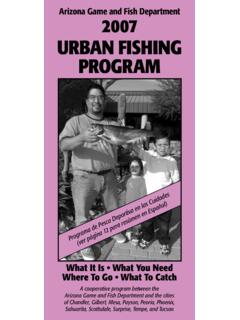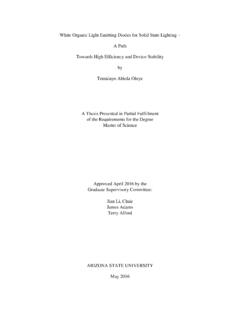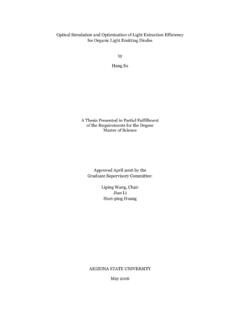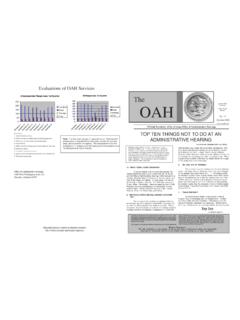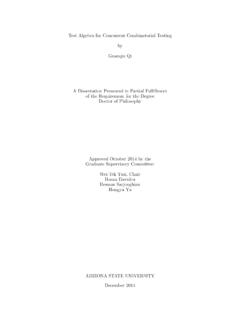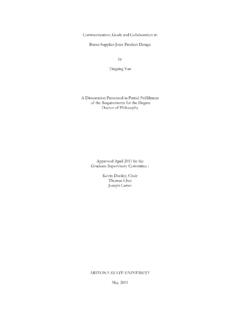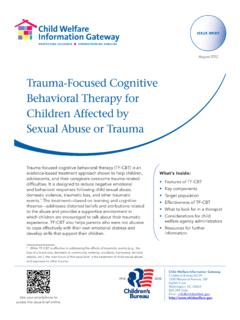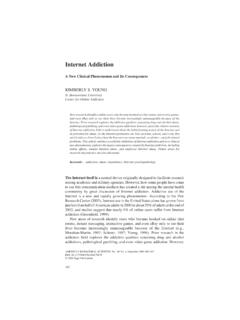Transcription of Teachers’ Use of Positive and Negative Feedback With ...
1 Teachers' Use of Positive and Negative Feedback With Students Who Are High-Risk for emotional behavioral disorders by Katie Sprouls A Dissertation Presented in Partial Fulfillment of the Requirements for the Degree Doctor of Philosophy Approved March 2011 by the Graduate Supervisory Committee: Sarup R. Mathur, Chair Carl Liaupsin Stanley Zucker ARIZONA STATE UNIVERSITY. May 2011. ABSTRACT. Teachers use different rates of Positive Feedback with students who are high-risk for emotional and behavioral disorders (EBD) in comparison to the rates of Positive Feedback teachers' use with low-risk students. By addressing the differential treatment, it may alleviate some of the related Negative effects students high-risk for EBD experience, such as poor educational and social outcomes.
2 The study explored the extent of teachers' differential use of Feedback toward students identified as high-risk and low-risk for EBD. The data were collected in 56 teachers' classrooms by measuring rates of Feedback delivered to 1 high-risk and 1 low-risk student per classroom (112 students total). Results revealed that teachers used Positive strategies infrequently with the students high- risk for EBD. Results further indicated that teachers were over reliant upon using Negative Feedback with high-risk students. Descriptive variables within the study, such as school-wide and teachers' self-evaluations of Positive classroom strategies, schools' special education population, and suspension rates were further explored. Implications for professional practice and potential future lines of inquiry on the differential treatment of students at risk for EBD in educational settings are presented.
3 I DEDICATION. For Sean, who was there through it all and provided endless love and support along the way. And, for Mom & Dad who instilled in me the importance of education and perseverance. ii ACKNOWLEDGMENTS. Without the guidance, support, and Feedback of a few distinct individuals, none of this could have been achieved. First and foremost, I was incredibly fortunate to have Dr. Sarup Mathur as a chair, mentor, colleague and friend. She was there through all the successes and set basks all the while fiercely supporting my interest, and for that I will be forever grateful. Additionally, the support and guidance of Dr. Carl Liaupsin and Dr. Stanley Zucker as committee members made this experience continually challenging, stimulating and humorous. Lastly, I want to acknowledge Dr.
4 Gita Upreti, Dr. Shana Hornstein, Dr. Wendy Oakes, Sean Chappell, Kerri Sorensen, and Terri Chace whose friendship, intellect, honesty and loyalty helped me achieve this goal with my sanity intact. iii TABLE OF CONTENTS. Page LIST OF TABLES ..ix LIST OF CHAPTER. 1 INTRODUCTION .. 1. How Did We Get Here? ..3. Experimental Analysis of Behavior ..4. Applied Behavior Analysis ..6. Schools as Providers of emotional and behavioral Services ..9. School-wide Positive Behavior Universal Supports ..12. Supplemental Intensive Supports ..14. Feedback as a Support and Feedback with EBD Promoting Positive Statement of the Problem ..20. Conceptual Framework ..23. The Purpose of the Study ..24. Research Questions and Hypothesis ..25. iv CHAPTER Page Definitions of 2 LITERATURE REVIEW.
5 30. Selection of Literature ..30. The Meaning of Positive and Negative Feedback ..33. The Effects of Assertion that Feedback is Ineffective ..37. Transparency of Lacking Intrinsic Influence of Judgment ..40. Feedback as a Valuable Effects on Motivation ..43. Effects on Self-efficacy ..46. Feedback to Promote a Positive Postive Feedback as a Consequence for Appropriate Feedback with Challenging Elements of Effective Clear Feedback ..54. Goal-directed Postively Framed Summary and v CHAPTER Page 3 59. Setting ..59. Teachers ..61. Measures ..63. Student Risk Screening Scale (SRSS)..62. Feedback Coding System ..62. School-wide Evaluation Tool (SET)..65. Classroom Management Self-assessment Observer Description of Observers and Observer Training ..67. Interobserver Data Collection.
6 68. Data 4 71. Normative Feedback Data ..71. Hypothesis Test and Analysis ..73. Difference Between Positive and Negative Feedback Low-risk High-risk Students ..78. vi CHAPTER Page 5 DISCUSSION .. 82. Normative Feedback Data ..83. Difference in Feedback Between Students High-risk and Low-risk for Low-risk Group ..87. High-risk Supplemental Descriptive SET Teacher Suspension Rates ..91. Special Education and the EBD Limitations and Implications for Future Implications for Personal Reflections ..97. REFERENCES .. 100. APPENDIX. A APPROVAL LETTERS .. 116. B PARTICIPATION AGREEMENT FORMS .. 119. C MEASURES USED IN STUDY .. 125. vii Page D DISAGGREATION OF DIFFERENCES BETWEEN HIGH-RISK. AND LOW-RISK GROUPS PRESENTED BY SCHOOL AND. TEACHER .. 137. viii LIST OF TABLES.
7 Table Page 1. Characteristics of Participating Schools .. 60. 2. Demographic Characteristics of Participating Teachers .. 62. 3. Demographic Characteristics of Target Students .. 63. 4. Mean Occurrences of Positive and Negative Feedback by Teacher Toward Student Population at Large in the Normative Phase .. 72. 5. Mean Occurrences of Positive and Negative Feedback by Teacher Toward Student Population at Large in the Normative Phase Dissected by School Including SET Scores .. 72. 6. Mean Occurrence of Positive and Negative Feedback by Risk Level and Reported Significance Level .. 75. 7. Mean Occurrences of Positive and Negative Feedback by Risk Level and School .. 75. ix LIST OF FIGURES. Figure Page 1. Conceptual Framework of the Elements of Effective Feedback .
8 24. 2. The Mean Occurrences of Positive and Negative Feedback During the Normative Phase in Grade Levels Kindergarten Through Fifth Grade .. 73. 3. Total Rate of Positive and Negative Feedback Received by Each Low- risk Student .. 77. 4. Total Rate of Positive and Negative Feedback Received by Each High- risk Student .. 80. 5. Differences Between the Rate of Feedback Recommended by the Literature and the Averages of the Observed Rates of Feedback .. 86. x Chapter 1. Introduction Schools are complex social structures that are as diverse as the students and faculty who attend and work within them. The educational system, like any complex social structure, has a unique set of factors to consider when measuring outcomes. Some prominent factors faced by educators today include increasing educational advancement, responsibilities, and accountability (Chatterji, 2002.)
9 Committee for Economic Development, 2001; Curran, 1999). Aside from those factors, disciplinary issues and problem behavior are some of the most common concerns voiced by educators in schools today (Skiba & Sprague, 2008; Utley, Kozleski, Smith, & Draper, 2002). The concerns of educators have been verified by statistics that show an increase in violent behavior warranting disciplinary action. According to the 2007-2008 National Center for Education Statistics (NCES) School Survey on Crime and Safety (SSOCS), of the 75% of schools reporting data, there were violent incidents per every 1000 students in schools (NCES, 2008, p. 7, Table 1). Violent incidents consist of rape, sexual battery other than rape, physical attack or fight, threat of physical attack, and robbery with or without a weapon.
10 Per every 100 students in United States public schools, there were incidents of vandalism, possession of a knife or sharp object, firearm, explosive device, and distribution, possession, or use of illegal drugs or alcohol; additionally, serious violent incidents occurred at the rate of and theft occurred at incidents per every 1000 students (Neiman, DeVoe, & Chandler, 2009). 1. Disciplinary incidents such as those noted above significantly impede the educational process within schools everyday. The NCES SSOCS found that bullying behaviors occur of the time on a daily and weekly basis (see Table 5 of NCES, 2008, for complete data). On a daily basis, student acts of disrespect for teacher and other verbal abuse occurred 10% of the time; verbal abuse of teachers occurred 6% of the time; and widespread disorder in the classroom occurred 4% of the time (Neiman et al.)
